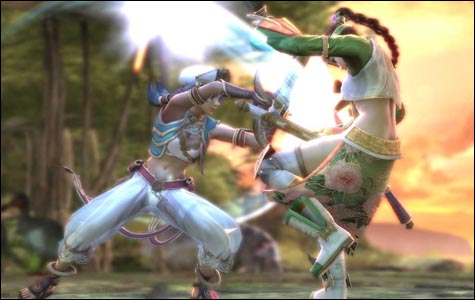
FIGHT CLUB:The era of bluffing your way through a fighting game with a frenzy of lucky button presses is over. |
| Soul Calibur IV | For the Xbox 360 and Playstation 3 | Rated T for Teen | Developed by Project Soul | Published by Bandai Namco |
Ten years ago, you couldn’t take a step through the electronics department without knocking over a stack of crappy fighting games. The market had hit its saturation point, with one mediocre cash-in after another flooding store shelves. Today, the situation is quite different. Only the best franchises have survived: Street Fighter, Tekken, Virtua Fighter, Soul Calibur. Although they remain successful properties, the release of Soul Calibur IV confirms the genre’s current status as a niche. There’s no disputing the quality of the product. But unless you’re intimate with its predecessors, you may find the barrier to entry too high.As a relative newcomer myself, I did read the manual to get a handle on the particulars of Soul Calibur’s fighting mechanics. That was my first mistake. The opening page of the manual tells you that it will henceforth refer to Horizontal Strikes as “A” and Vertical Strikes as “B.” If you’re playing the Xbox 360 version, that means you’ll want to hit the X button to perform A and the Y button to perform B. But don’t press the A button if you want to A! Press A to G, and B if you want to K. Got it?

Yes, it’s pretty nonsensical — as though the manual had been translated from Japanese by someone who speaks only French. The best way to learn is to dive in and start splashing around, and Soul Calibur IV is forgiving on this front. The single-player story mode is brief and easy, even for a novice. It’s a battle across five short stages for possession of two sacred swords, with a different text intro and cinematic ending for each combatant. Along the way — almost without trying — you unlock new fighters, new stages, and new weapons. You also start to get a handle on the tempo of play and some of the vagaries of the combat.
Then, brimming with confidence and inner centeredness, you play on-line and get destroyed before you even realize the match has begun. The era of bluffing your way through a fighting game with a frenzy of lucky button presses is over. (How I long for the halcyon days of Mortal Kombat!) The weapons-based fighting offers an endless array of defensive maneuvers and counterattacks, all requiring exquisite timing.
Each combatant plays in a noticeably different way, from the hulking Astaroth to the lithe Sophitia. Past fighting games tended to reuse character models and combat techniques; in Soul Calibur, everyone is unique. That adds a lot to the experience. Even more exciting for the casual fan is the inclusion of some familiar faces from the Star Wars universe — Darth Vader in the PS3 version, Yoda for the Xbox 360. Light sabers mesh surprisingly well with the more archaic armaments of the Soul Calibur universe.
The real money, however, is in the deep character-creation tool. This feature too is not instantly accessible to the casual fan. By earning points in single-player mode, you can purchase weapons, armor, and abilities for your custom fighter. Said abilities aren’t clearly explained in the game, and they’re not mentioned in the manual. “Shave Damage” and “Hysterical Strength” would be excellent names for a hardcore band, but they aren’t terribly descriptive as attributes for a custom warrior. Well, that’s why they invented GameFAQs.com.
What’s especially neat is that when you play against user-created characters on-line, you’ll have no idea what to expect from a given character model and will have to adapt strategies on the fly. Assuming, of course, you know your A from your B.